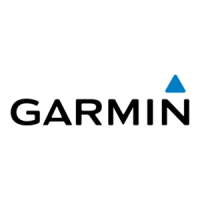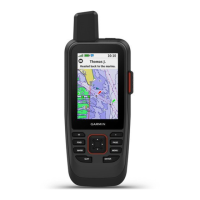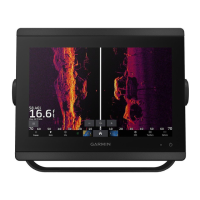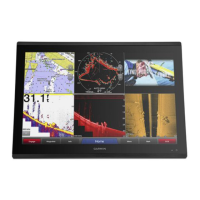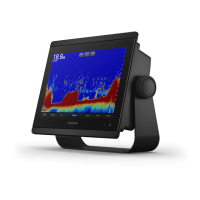Do you have a question about the Garmin GPSMAP 8612xsv and is the answer not in the manual?
Illustrates and describes the various ports and connectors on the chartplotter models.
Overview of the home screen layout and access to chartplotter features.
Explains how to enable screen lock with a PIN for security.
Provides steps to create custom combination pages with multiple windows.
Explains how to add SmartMode layouts to suit specific needs and activities.
Details how to customize layouts and data shown in combination and SmartMode pages.
Overview of using voice commands to control the chartplotter with a headset.
Lists common voice commands for device, screen, vessel, and media functions.
Instructions for pairing and using the GRID remote control with the chartplotter.
Guides on connecting a mobile device to the GPSMAP device using the ActiveCaptain app.
Explains how to enable and set up smart notifications from a mobile device.
Details how notifications appear and how to interact with them on the GPSMAP screen.
Guides on downloading and installing software updates using the ActiveCaptain app.
Explains how to download and transfer chart updates using the ActiveCaptain app.
Covers setting up and connecting to the chartplotter's Wi-Fi network.
Details pairing, controlling backlight, and disconnecting wireless remote controls.
Describes the features and optimization of Navigation and Fishing charts.
Instructions on setting a course and navigating to a selected destination on the chart.
Details premium chart features like Mariner's Eye 3D and Fish Eye 3D views.
Explains how AIS helps identify and track other vessels and alerts for traffic.
Configures a collision alarm for safe zone entry using AIS and MARPA.
Describes AIS distress signals and navigating to distress signal transmissions.
Details how to overlay radar information on navigation and fishing charts.
Guides on using Quickdraw Contours to map depth, GPS position, and sonar data.
Steps to access the community via the ActiveCaptain app for map sharing.
Guides on downloading maps created by other users via the ActiveCaptain app.
Steps to access the community via Garmin Connect for map sharing.
Direct navigation to a destination, creating a straight-line course.
Creates a route with turns from current location to a destination.
Steps to set and follow a direct course using the Go To function.
Explains Auto Guidance feature for plotting the best path to a destination.
Steps to set and follow an Auto Guidance path to a destination.
Sets parameters for Auto Guidance path calculation like preferred depth and clearance.
Enhances the likelihood of crossing the start line exactly when the race begins.
Provides visual guidance to cross the start line at the optimal time and speed.
Explains how to use starting line guidance for optimal race start speed.
Allows autopilot to maintain a specific bearing relative to the current wind angle.
Enables autopilot to perform tacks or gybes while holding heading or wind.
Provides a detailed picture of the fishing environment using high-frequency sonar.
Shows a picture of what lies to the sides of the boat for structure and fish finding.
Overview of Panoptix sonar views including LiveVü and RealVü 3D.
Increases situational awareness by showing obstructions up to 91 meters ahead.
Shows a live view of what is in front of or below the boat to see fish and structures.
Guides on setting the transducer type for proper sonar function.
Sets sonar alarms for shallow water, deep water, fish, and contour detection.
Configures transducer settings for different sonar types.
Explains how transducer frequencies affect sonar performance.
Covers settings for Panoptix sonar views, including angle and sweep speed.
Provides guidance on reading and interpreting radar display data.
Explains how to overlay radar information on navigation and fishing charts.
Instructions on how to transmit radar signals and enter standby mode.
Controls the radar signal range for optimal target detection.
Detects and highlights moving targets using Doppler effect for collision avoidance.
Sets up a guard zone to alert when anything enters a specified area around the boat.
Defines a circular guard zone that completely surrounds the boat.
Defines boundaries of a guard zone that does not completely surround the boat.
Mini-automatic radar plotting aid for target identification and collision avoidance.
How to view and customize lists of AIS and MARPA threats from the radar screen.
Adjusts radar gain automatically or manually for optimal performance.
Provides steps for manually adjusting radar gain for optimal performance.
Adjusts sea clutter, rain clutter, and averages multiple scans for clarity.
Accesses features like MotionScope, Echo Trails, VRM/EBL, and Guard Zone.
Covers radar source, chart display, orientation, and crosstalk rejection.
Notes on proper installation and configuration by a qualified installer.
Guides on selecting the heading source for optimal autopilot performance.
Explains how to enable Shadow Drive for manual steering to disengage autopilot.
Instructions on how to engage the autopilot to maintain heading.
Guides on adjusting heading using the helm while the autopilot is engaged.
Information on wirelessly connecting a Reactor autopilot remote control.
Details on controlling the Yamaha autopilot system via the chartplotter.
Connects and controls the Force trolling motor using the chartplotter.
Covers calibration, anchor gain, navigation gain, and arrival mode settings.
Steps to calibrate the trolling motor compass for autopilot features.
Explains features enabled by connecting a chartplotter to a VHF radio.
Details how chartplotter alerts for DSC distress calls received by the VHF radio.
Guides on navigating to a vessel that has made a distress call.
Configures upper/lower limits and desired operation ranges for gauges.
Enables the chartplotter to display engine status alarms.
Instructions on viewing Yamaha engine gauges based on network and controller.
Identifies engine abnormalities indicated by red icons.
Covers trip, maintenance reminder, tank preset, and trim assist settings.
Instructions for viewing Mercury engine gauges via SmartCraft Connect gateway.
Sets an alarm for when the total onboard fuel reaches a specified level.
Guides on connecting an inReach device for message management.
Controls the Power-Pole anchor system via the chartplotter.
Enables the Power-Pole overlay on the chartplotter for anchor control.
Selects the required installation mode for Power-Pole anchor control.
Activates the Mercury Helm feature for controlling Mercury engines and overlays.
Sets and adjusts trolling speed using the Mercury Troll overlay.
Sets and adjusts cruise-control functions for compatible Mercury engines.
Accesses and controls the Dometic Optimus system, including overlays and alerts.
Information on connecting and viewing video from networked cameras.
Controls camera movements like panning, tilting, and zooming using on-screen controls.
Supports tracking cameras on fixed directions or specific vessels.
Locks the camera onto a compass direction regardless of vessel heading.
Locks the camera onto a target using information from other devices.
Covers display, GPS, system information, station, and power settings.
Adjusts beeper, audio output, backlight, color mode, and screen lock.
Sets units, language, navigation preferences, filters, and keyboard layout.
Sets route labels, turn transition, speed sources, and Auto Guidance parameters.
Sets parameters for Auto Guidance path calculation like preferred depth and clearance.
Covers NMEA 0183 and NMEA 2000 settings, and output sentence configuration.
Covers device list, labeling devices, and Garmin Marine Network settings.
Configures navigation alarms like arrival, anchor drag, and off course.
Covers transducer, depth, fuel, vessel type, and system profile settings.
Compensates depth readings for transducer location relative to the keel.
Allows monitoring fuel remaining using flow or tank sensors and setting capacity.
Sets display of AIS, DSC, collision alarms, and EPIRB/MOB/SART tests.
Resets device settings to factory defaults without removing user data.
Transfers user data from a memory card to the chartplotter or combines it.
Saves user data to a memory card for transfer to other devices.
Updates built-in maps using Garmin Express and a memory card.
Overview of apps for managing chartplotter, charts, and device updates.
Details on using Garmin Express for software and chart updates.
Guides on registering your device using the Garmin Express app.
Steps to update charts using Garmin Express and a memory card.
Guidance on updating device software via mobile app or Garmin Express.
Instructions for copying software updates to a memory card via computer.
Steps to update device software using a memory card.
Connects chartplotter to computer for touchscreen control and viewing.
Instructions for connecting computer to chartplotter for touchscreen control.
Guides on connecting and controlling a computer using the chartplotter touchscreen.
Provides solutions for common issues like no GPS signal.
Troubleshoots issues with acquiring GPS satellite signals.
Troubleshoots power issues, including checking fuses and voltage.
Troubleshoots waypoint creation issues related to map datum and position format.
Illustrates and describes the various ports and connectors on the chartplotter models.
Overview of the home screen layout and access to chartplotter features.
Explains how to enable screen lock with a PIN for security.
Provides steps to create custom combination pages with multiple windows.
Explains how to add SmartMode layouts to suit specific needs and activities.
Details how to customize layouts and data shown in combination and SmartMode pages.
Overview of using voice commands to control the chartplotter with a headset.
Lists common voice commands for device, screen, vessel, and media functions.
Instructions for pairing and using the GRID remote control with the chartplotter.
Guides on connecting a mobile device to the GPSMAP device using the ActiveCaptain app.
Explains how to enable and set up smart notifications from a mobile device.
Details how notifications appear and how to interact with them on the GPSMAP screen.
Guides on downloading and installing software updates using the ActiveCaptain app.
Explains how to download and transfer chart updates using the ActiveCaptain app.
Covers setting up and connecting to the chartplotter's Wi-Fi network.
Details pairing, controlling backlight, and disconnecting wireless remote controls.
Describes the features and optimization of Navigation and Fishing charts.
Instructions on setting a course and navigating to a selected destination on the chart.
Details premium chart features like Mariner's Eye 3D and Fish Eye 3D views.
Explains how AIS helps identify and track other vessels and alerts for traffic.
Configures a collision alarm for safe zone entry using AIS and MARPA.
Describes AIS distress signals and navigating to distress signal transmissions.
Details how to overlay radar information on navigation and fishing charts.
Guides on using Quickdraw Contours to map depth, GPS position, and sonar data.
Steps to access the community via the ActiveCaptain app for map sharing.
Guides on downloading maps created by other users via the ActiveCaptain app.
Steps to access the community via Garmin Connect for map sharing.
Direct navigation to a destination, creating a straight-line course.
Creates a route with turns from current location to a destination.
Steps to set and follow a direct course using the Go To function.
Explains Auto Guidance feature for plotting the best path to a destination.
Steps to set and follow an Auto Guidance path to a destination.
Sets parameters for Auto Guidance path calculation like preferred depth and clearance.
Enhances the likelihood of crossing the start line exactly when the race begins.
Provides visual guidance to cross the start line at the optimal time and speed.
Explains how to use starting line guidance for optimal race start speed.
Allows autopilot to maintain a specific bearing relative to the current wind angle.
Enables autopilot to perform tacks or gybes while holding heading or wind.
Provides a detailed picture of the fishing environment using high-frequency sonar.
Shows a picture of what lies to the sides of the boat for structure and fish finding.
Overview of Panoptix sonar views including LiveVü and RealVü 3D.
Increases situational awareness by showing obstructions up to 91 meters ahead.
Shows a live view of what is in front of or below the boat to see fish and structures.
Guides on setting the transducer type for proper sonar function.
Sets sonar alarms for shallow water, deep water, fish, and contour detection.
Configures transducer settings for different sonar types.
Explains how transducer frequencies affect sonar performance.
Covers settings for Panoptix sonar views, including angle and sweep speed.
Provides guidance on reading and interpreting radar display data.
Explains how to overlay radar information on navigation and fishing charts.
Instructions on how to transmit radar signals and enter standby mode.
Controls the radar signal range for optimal target detection.
Detects and highlights moving targets using Doppler effect for collision avoidance.
Sets up a guard zone to alert when anything enters a specified area around the boat.
Defines a circular guard zone that completely surrounds the boat.
Defines boundaries of a guard zone that does not completely surround the boat.
Mini-automatic radar plotting aid for target identification and collision avoidance.
How to view and customize lists of AIS and MARPA threats from the radar screen.
Adjusts radar gain automatically or manually for optimal performance.
Provides steps for manually adjusting radar gain for optimal performance.
Adjusts sea clutter, rain clutter, and averages multiple scans for clarity.
Accesses features like MotionScope, Echo Trails, VRM/EBL, and Guard Zone.
Covers radar source, chart display, orientation, and crosstalk rejection.
Notes on proper installation and configuration by a qualified installer.
Guides on selecting the heading source for optimal autopilot performance.
Explains how to enable Shadow Drive for manual steering to disengage autopilot.
Instructions on how to engage the autopilot to maintain heading.
Guides on adjusting heading using the helm while the autopilot is engaged.
Information on wirelessly connecting a Reactor autopilot remote control.
Details on controlling the Yamaha autopilot system via the chartplotter.
Connects and controls the Force trolling motor using the chartplotter.
Covers calibration, anchor gain, navigation gain, and arrival mode settings.
Steps to calibrate the trolling motor compass for autopilot features.
Explains features enabled by connecting a chartplotter to a VHF radio.
Details how chartplotter alerts for DSC distress calls received by the VHF radio.
Guides on navigating to a vessel that has made a distress call.
Configures upper/lower limits and desired operation ranges for gauges.
Enables the chartplotter to display engine status alarms.
Instructions on viewing Yamaha engine gauges based on network and controller.
Identifies engine abnormalities indicated by red icons.
Covers trip, maintenance reminder, tank preset, and trim assist settings.
Instructions for viewing Mercury engine gauges via SmartCraft Connect gateway.
Sets an alarm for when the total onboard fuel reaches a specified level.
Guides on connecting an inReach device for message management.
Controls the Power-Pole anchor system via the chartplotter.
Enables the Power-Pole overlay on the chartplotter for anchor control.
Selects the required installation mode for Power-Pole anchor control.
Activates the Mercury Helm feature for controlling Mercury engines and overlays.
Sets and adjusts trolling speed using the Mercury Troll overlay.
Sets and adjusts cruise-control functions for compatible Mercury engines.
Accesses and controls the Dometic Optimus system, including overlays and alerts.
Information on connecting and viewing video from networked cameras.
Controls camera movements like panning, tilting, and zooming using on-screen controls.
Supports tracking cameras on fixed directions or specific vessels.
Locks the camera onto a compass direction regardless of vessel heading.
Locks the camera onto a target using information from other devices.
Covers display, GPS, system information, station, and power settings.
Adjusts beeper, audio output, backlight, color mode, and screen lock.
Sets units, language, navigation preferences, filters, and keyboard layout.
Sets route labels, turn transition, speed sources, and Auto Guidance parameters.
Sets parameters for Auto Guidance path calculation like preferred depth and clearance.
Covers NMEA 0183 and NMEA 2000 settings, and output sentence configuration.
Covers device list, labeling devices, and Garmin Marine Network settings.
Configures navigation alarms like arrival, anchor drag, and off course.
Covers transducer, depth, fuel, vessel type, and system profile settings.
Compensates depth readings for transducer location relative to the keel.
Allows monitoring fuel remaining using flow or tank sensors and setting capacity.
Sets display of AIS, DSC, collision alarms, and EPIRB/MOB/SART tests.
Resets device settings to factory defaults without removing user data.
Transfers user data from a memory card to the chartplotter or combines it.
Saves user data to a memory card for transfer to other devices.
Updates built-in maps using Garmin Express and a memory card.
Overview of apps for managing chartplotter, charts, and device updates.
Details on using Garmin Express for software and chart updates.
Guides on registering your device using the Garmin Express app.
Steps to update charts using Garmin Express and a memory card.
Guidance on updating device software via mobile app or Garmin Express.
Instructions for copying software updates to a memory card via computer.
Steps to update device software using a memory card.
Connects chartplotter to computer for touchscreen control and viewing.
Instructions for connecting computer to chartplotter for touchscreen control.
Guides on connecting and controlling a computer using the chartplotter touchscreen.
Provides solutions for common issues like no GPS signal.
Troubleshoots issues with acquiring GPS satellite signals.
Troubleshoots power issues, including checking fuses and voltage.
Troubleshoots waypoint creation issues related to map datum and position format.
| Display Resolution | 1280 x 800 pixels |
|---|---|
| Sonar | Yes |
| Routes | 100 |
| Track Log | 50, 000 points; 50 saved tracks |
| GPS Receiver | 10 Hz |
| Water Rating | IPX7 |
| Antenna | Internal or external over NMEA 2000 |
| NMEA 2000 Ports | 1 |
| Garmin Marine Network Ports | 2 |
| J1939 Ports | 1 |
| Radar Compatibility | Yes |
| Power Input | 10-32 Vdc |
| Preloaded Maps | Worldwide basemap |
| Networking | NMEA 2000 |
| Waypoints | 5000 |
| Mounting Options | Flush |
| Power Consumption | Max 3.5A @ 12V |
| NMEA 0183 Input Ports | 2 |
| NMEA 0183 Output Ports | 2 |
| Wireless Connectivity | Wi-Fi® |
| Weight | 2.3 kg |
| Sonar Compatibility | Built-in |
